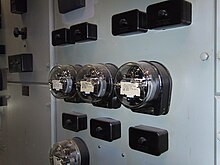
Back مرحل واق Arabic Mühafizə relesi Azerbaijani رله حفاظتی Persian Suojarele Finnish रक्षी रिले Hindi Relai proteksi ID 保護継電器 Japanese Reläskydd Swedish Rơ le bảo vệ Vietnamese 保护继电器 Chinese
| Part of a series on |
| Power engineering |
|---|
| Electric power conversion |
| Electric power infrastructure |
| Electric power systems components |

In electrical engineering, a protective relay is a relay device designed to trip a circuit breaker when a fault is detected.[1]: 4 The first protective relays were electromagnetic devices, relying on coils operating on moving parts to provide detection of abnormal operating conditions such as over-current, overvoltage, reverse power flow, over-frequency, and under-frequency.[2]
Microprocessor-based solid-state digital protection relays now emulate the original devices, as well as providing types of protection and supervision impractical with electromechanical relays. Electromechanical relays provide only rudimentary indication of the location and origin of a fault.[3] In many cases a single microprocessor relay provides functions that would take two or more electromechanical devices. By combining several functions in one case, numerical relays also save capital cost and maintenance cost over electromechanical relays.[4] However, due to their very long life span, tens of thousands of these "silent sentinels"[5] are still protecting transmission lines and electrical apparatus all over the world. Important transmission lines and generators have cubicles dedicated to protection, with many individual electromechanical devices, or one or two microprocessor relays.
The theory and application of these protective devices is an important part of the education of a power engineer who specializes in power system protection. The need to act quickly to protect circuits and equipment often requires protective relays to respond and trip a breaker within a few thousandths of a second. In some instances these clearance times are prescribed in legislation or operating rules.[6] A maintenance or testing program is used to determine the performance and availability of protection systems.[7]
Based on the end application and applicable legislation, various standards such as ANSI C37.90, IEC255-4, IEC60255-3, and IAC govern the response time of the relay to the fault conditions that may occur.[8]
- ^ Cite error: The named reference
YGPwas invoked but never defined (see the help page). - ^ Lundqvist, Bertil. "100 years of relay protection, the Swedish ABB relay history" (PDF). ABB. Retrieved 30 December 2015.
- ^ Schossig, Walter (September 2014). "Protection History". Pacworld. Retrieved 30 December 2015.
- ^ Mooney, Joe (March 25–28, 1996). Microprocessor-Based Transmission Line Relay Applications. American Public Power Association's Engineering & Operations Workshop. Salt Lake City, Utah: Schweitzer Engineering Laboratories, Inc. p. 1.
- ^ Silent Sentinels. Newark, New Jersey: Westinghouse Electric & Manufacturing Company. 1940. p. 3.
- ^ "AEMC - Current Rules". www.aemc.gov.au. Retrieved 2015-12-30.
- ^ "Protection System Maintenance - A Technical Reference" (PDF). www.nerc.com. p. 1. Retrieved 2016-01-05.
- ^ Cite error: The named reference
:1was invoked but never defined (see the help page).
© MMXXIII Rich X Search. We shall prevail. All rights reserved. Rich X Search